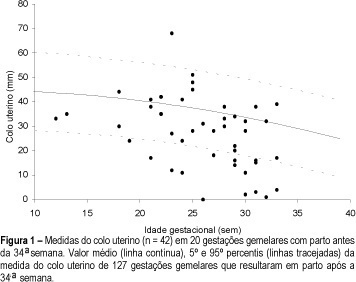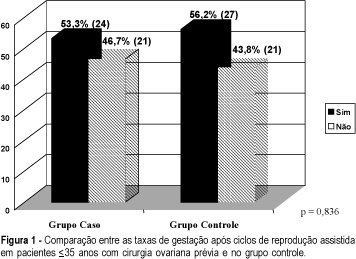Summary
Revista Brasileira de Ginecologia e Obstetrícia. 2002;24(7):441-446
DOI 10.1590/S0100-72032002000700003
Purpose: to evaluate the reproductive aspects in climacteric women of the Family Health Program in Cuiabá. Methods: it was a cross-sectional study including 354 women, with ages between 40 and 65 years, attended at the Central-Western District Family Health Program of Cuiabá. A pretested questionnaire with specific questions regarding the present study was used. Data were analyzed using the Z test and chi² test for trend. The mean age of the 354 women was 49.7±7 years and the median 48 years. A total of 243 (68.6%) were born in Mato Grosso, and the others were migrants from different states. Most were married (65.8%), white (48.0%), catholic (73.4%), and had low schooling: 62.4% did not finish the elementary school and 19.2% were illiterate. About 84% were occupied only in domestic activities, and more than a half (58.2%) belonged to a lower social class. Results: the average number of pregnancies was 5.4±3.3. Nearly 5% were nulliparous and 7% had more than ten children. Almost 50% had the first pregnancy in adolescence and 14% after the age of 40 years. A total of 229 women (65%) were submitted to pelvic surgery: 78% to tubal sterilization, 20% to hysterectomy, and 7% to bilateral oophorectomy. Menopause was due to hysterectomy/oophorectomy in 25% of the women. Conclusion: almost 65% of the women were submitted to a pelvic surgery. The most frequent surgery was tubal sterilization followed by total hysterectomy.
Summary
Revista Brasileira de Ginecologia e Obstetrícia. 2002;24(7):433-438
DOI 10.1590/S0100-72032002000700002
Purpose: to analyze the correlation between Valsalva leak point pressure and maximum urethral closure pressure and clinical symptoms in women with stress urinary incontinence. Methods: we analyzed retrospectively 164 patients with urodynamic diagnosis of stress and mixed urinary incontinence established by the Urogynecology and Vaginal Surgery Sector of UNIFESP/EPM. All patients were submmited to medical interview, physical examination and urodynamic study. Patients were divided into groups according to the subjective degree of stress urinary incontinence. Valsalva leak point pressure (VLPP) was measured with a vesical volume of 200 mL. Urethral profile was determined using a flow catheter number 8 with measurement of maximum urethral closure pressure (MUCP). Data were compared by chi², ANOVA and Tukey tests. Results: mean age was 51.2 years (19-82), 76 women (47.2%) were in menacme and 85 (52.8%) in postmenopausal status. Mean parity was 3.9 (0-18). The exact test for trend demonstrated a statistically significant (p<0.0001) correlation between the number of patients with VLPP of 60 cmH2O or less and clinical complaints. The group with severe leakage had mean VLPP of 69.1 cmH2O. The group with moderated leakage had mean VLPP of 84.6 cmH2O and the group with mild leakage had mean VLPP of 90.6 cmH2O. Conclusions: VLPP correlated with the subjective degree of stress urinary incontinence. Higher grades of stress urinary incontinence had a higher likelyhood of a low VLPP. MUCP did not correlate with clinical complaints.
Summary
Revista Brasileira de Ginecologia e Obstetrícia. 2002;24(6):401-406
DOI 10.1590/S0100-72032002000600007
Purpose: to evaluate, in the high-risk pregnancies with oligohydramnios, the assessment tools for fetal well-being and perinatal results. Methods: five hundred seventy-two high-risk pregnancies were retrospectively analyzed. All of them presented with oligohydramnios established by AFI <=5.0 cm. Severe oligohydramnios was detected in 220 cases (AFI<=3,0 cm). The fetal well-being tests included: antepartum cardiotocography, biophysical profile score (BPS) and dopplervelocimetry of umbilical and middle cerebral arteries. Multiple gestation, fetal anomalies and premature rupture of membrane cases were excluded. Results: severe oligohydramnios was significantlly associated with abnormal and suspected cardiotocography results (23.2%), abnormal biophysical profile score (10.5%), abnormal results of middle cerebral artery dopplervelocimetry (54.5%), small for gestational age infants (32.7%) and meconial amniotic fluid (27.9%) when compared to pregnancies with AFI between 3.1 and 5.0 cm. This group presented: abnormal or suspected cardiotocography results (13.9%), abnormal biophysical profile score (4.3%), abnormal results of middle cerebral artery dopplervelocimetry (33.9%), small for gestational age infants (21.0%) and meconial amniotic fluid (16.8%). Conclusion: the oligohydramnios severity in high-risk pregnancies allows to discriminate the cases that are related to adverse perinatal outcome.

Summary
Revista Brasileira de Ginecologia e Obstetrícia. 2002;24(6):389-394
DOI 10.1590/S0100-72032002000600006
Purpose: to study the influence of weight differences between twins on the perinatal results. Methods: the twin deliveries at the Maternity of the Hospital Regional de Clínicas de Sorocaba, SP, were retrospectively analyzed from July 1997 to June 1998. The samples were 89 mothers and their twins, divided into three classes of newborn weight differences, as follows: concordant (<15%), mild discordance (15 to 25%) and severe discordance (>25%). The independent variables analyzed were these three classes and the dependent variables were low weight at birth, Apgar index less than 7 at the first and fifth minute, premature delivery, time of permanence of the newborn in the nursery, and perinatal mortality coefficient I. Statistical analysis was performed using Kruskal-Wallis test, completed by Hollander test, and the Blackwell test. Results: the number of pregnancies (62, 17 and 10) and premature deliveries (32, 9 and 7) were observed respectively in the three classes. For the first and second twins we observed: low weight at birth (39/41, 13/12 and 8/9), Apgar index less than 7 at the first minute (16/13, 3/7 and 2/3), Apgar index at the fifth minute (4/4, 0/2 and 1/2), time (in days) of permanence of the newborn in the nursery (3.7/3.7, 4.6/6.0 and 7.3/8.7) and perinatal mortality coefficient I (22.4/16.8, 0/16.8 and 5.6/5.6). Conclusions: the incidence of weight discordance between twins was 30.3%, 19.1% being mild discordance and 11.2% severe discordance. There was a tendency to a progressive aggravation of perinatal results considering the degree of discordance of the classes (concordant < mild discordance < severe discordance).
Summary
Revista Brasileira de Ginecologia e Obstetrícia. 2002;24(6):383-387
DOI 10.1590/S0100-72032002000600005
Purpose: to evaluate the effectiveness of diagnostic amnioinfusion in severe oligohydramnios. Methods: twelve patients with severe oligohydramnios in the second and third trimester of pregnancy were submitted to amnioinfusion. The procedure was done using a warm physiological saline at a rate of 20 mL/min followed by the instillation of 5 mL of dye. The amniotic fluid index (AFI) was measured before the procedure and 30 min afterwards and in case of fetal anomalies, it was documented. The gestational age ranged from 18 to 34 weeks (average 25 ± 4 weeks). The average of the initial ILA was 10.3cm and after the procedure was 16.4 cm. The volume of saline solution infused ranged from 300 to 1000 mL (605.4 ± 224.1 mL). Results: in nine patients (75%) the procedure led to an etiologic diagnosis: four cases of premature rupture of membranes and major malformations in five fetuses. In two patients the oligohydramnios was considered idiopathic and in one patient the pathological examination revealed a placental infarct. Nine pregnancies (75%) were interrupted after the diagnosis and in three cases it was maintained for 8.8 weeks after the amnioinfusion. All fetuses died, seven of them had neonatal death and the remaining had intrauterine death. Conclusion: amnioinfusion is an effective method with high precision, enabling the etiologic diagnosis of severe oligohydramnios in 75% of the cases.
Summary
Revista Brasileira de Ginecologia e Obstetrícia. 2002;24(6):377-381
DOI 10.1590/S0100-72032002000600004
Purpose: to establish a reference range for cervical length measurement throughout gestation in twin pregnancies and to correlate cervical length with gestational age at delivery. Methods: retrospective analysis of prospectively collected data between 1994 and 2000, involving 149 twin pregnancies undergoing transvaginal ultrasound examination every four weeks for measurement of cervical length. Results: one hundred and twenty-seven women (85.2%) delivered after 34 weeks, 20 (13.4%) between 24 and 33 weeks and two pregnancies resulted in fetal loss before 24 weeks. The mean gestational age at delivery was 36.3 weeks. A total of 497 ultrasound examinations with cervical length measurement were performed in 127 patients with twin pregnancies who delivered after 34 weeks (mean = 4 examinations per patient). All scans were carried out between 9 and 39 weeks (mean = 29.4 weeks). There was an inverse correlation between cervical length measurement and gestational age at the scan in twin pregnancies (r=-0.44; p < 0.0001). The mean value was 44 mm at 10 weeks and 28 mm at 36 weeks. The corresponding fifth percentile values of these gestations were 28 mm and 12 mm, respectively. Cervical length measurement changes were more pronounced in the second half of the pregnancy (Kruskal-Wallis test, p=0.0006). Mean cervical length measurement and 90% prediction interval values were established throughout gestation by regression analysis. Twenty-six cases delivered before 34 weeks, nine of these cases (34.6%) had at least one cervical length measurement below the 5th percentile. Conclusions: cervical length shortens gradually throughout gestation in twin pregnancies but changes are more significant in the second half of the pregnancy. Approximately one-third of the pregnancies that delivered before 34 weeks had at least one cervical length measurement below the 5th percentile for the gestational age.

Summary
Revista Brasileira de Ginecologia e Obstetrícia. 2002;24(6):371-376
DOI 10.1590/S0100-72032002000600003
Purpose: to evaluate the effect of previous ovarian surgery for endometriosis on the ovarian response in assisted reproduction treatment cycles and its pregnancy outcome. Methods: a total of 61 women, with primary infertility and previous ovarian surgery for endometriosis, submitted to 74 in vitro fertilization/intracytoplasmic spermatozoid injection (IVF/ICSI) cycles, were studied (study group). A further 74 patients with primary infertility who underwent 77 IVF/ICSI cycles within the same period of time, at the same clinic and without previous ovarian surgery or endometriosis were studied as control group. Patients were matched for age and performed treatment. The groups were compared regarding number of ampoules used for superovulation, duration of folliculogenesis, number of follicles, number of oocytes, fertilization and pregnancy rate. IVF started with long protocol GnRHa for pituitary suppression followed by superovulation. After oocyte collection, in vitro insemination or sperm injection was performed and embryos were transferred from day 2 to day 5. Results: patients <35 years with previous ovarian surgery had less oocytes retrieved than the patients of the control group (p=0.049). Number of ampoules used for superovulation, duration of folliculogenesis, number of follicles, and fertilization rate were similar in both groups. The same was observed for pregnancy rates, as 24 patients (53.3%) with previous ovarian surgery and 27 (56.2%) of the control group became pregnant. Patients >35 years with previous ovarian surgery needed more ampoules for superovulation (p=0.017) and had less follicles and oocytes than women of the control group (p=0.001). Duration of folliculogenesis was similar in both groups, as was fertilization rate. A total of 10 patients achieved pregnancy in the study group (34.5%) and 14 (48.3%) in the control group. Conclusion: ovarian surgery for endometriosis reduced the ovarian outcome in IVF/ICSI cycles in women >35 years old, and might also decrease pregnancy rates. Therefore, we believe that for infertile patients, a conservative treatment might be a better option to avoid the reduction of ovarian response.
